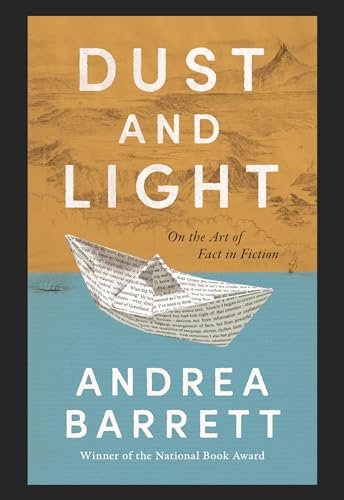
18 May Book Review of Dust and Light: On the Art of Fact in Fiction
Exploring "Dust and Light: On the Art of Fact in Fiction" by Andrea Barrett
As a longtime admirer of Andrea Barrett’s fiction, the release of her non-fiction work, Dust and Light: On the Art of Fact in Fiction, had me both excited and cautiously optimistic. To hear Barrett express her thoughts on the intersection of history and fiction felt like a privilege, yet deep down, I questioned whether I would connect with this new endeavor as I had with her captivating narratives. I dove in with an eager heart, ready for insights from a writer whose prose has always enchanted me.
From the very beginning, Barrett engages us in a discussion about the intricate dance of historical fiction, a genre she navigates with grace and precision. She weaves in examples from literary giants like Virginia Woolf and Leo Tolstoy, frequently circling back to how their masterpieces were birthed and transformed through persistent revision. Herein lies a double-edged sword: while her references lend authority to her arguments, they can also create a barrier for readers who might not have ventured into the works she cites. My familiarity with these authors added layers to my understanding, but I couldn’t help but wonder how those less acquainted with Woolf or Tolstoy might find themselves lost amid the rich tapestry of Barrett’s analysis.
One of the standout moments for me was her exploration of Anna Karenina and how it evolved from the character of Tatiana into Anna. This evolution not only illuminated Tolstoy’s growth but also resonated deeply with my own creative journeys. Barrett’s keen observations about transformation and rewriting shone brightly during these passages. They reminded me of the painstaking dedication that writers like Tolstoy exhibit, serving as a wonderful encouragement for anyone grappling with their craft.
What I cherished most were the candid glimpses into Barrett’s own writing process. Her descriptions of research and the delicate balancing act of weaving fact with fiction provided an intimate look at the hard work behind her beautiful prose. She opened a door to her world, and for that, I am grateful. However, it’s worth noting that these sections felt like the heart of the book—where Barrett’s voice truly thrived—while the broader discussions sometimes felt distant unless you shared her extensive literary background.
While I recognize the book may resonate primarily with seasoned readers—those who can engage deeply with Barrett’s literary references—there’s certainly a treasure trove of wisdom for any aspiring writer. The nuances of researching, selecting, and integrating facts are invaluable lessons for those of us striving to hone our craft.
In conclusion, Dust and Light offers a rich exploration of the art of writing historical fiction, but its resonance may be limited to a niche audience familiar with the authors discussed. For die-hard fans of Barrett or those steeped in literary history, this book is a gem, brimming with insight. For others, it may feel like missing pieces in a puzzle, captivating in parts but not wholly satisfying.
As I closed the book, I found myself reflecting not just on Barrett’s experience but on my own journey as a reader and writer. This book urges us to delve deeper into our literary explorations, reminding us that every fact has the potential to transform fiction, just as fiction can illuminate our understanding of history. If you find yourself as fascinated as I am with the interplay between narrative and reality, then perhaps Dust and Light will beckon you in all the right ways.
Discover more about Dust and Light: On the Art of Fact in Fiction on GoodReads >>









